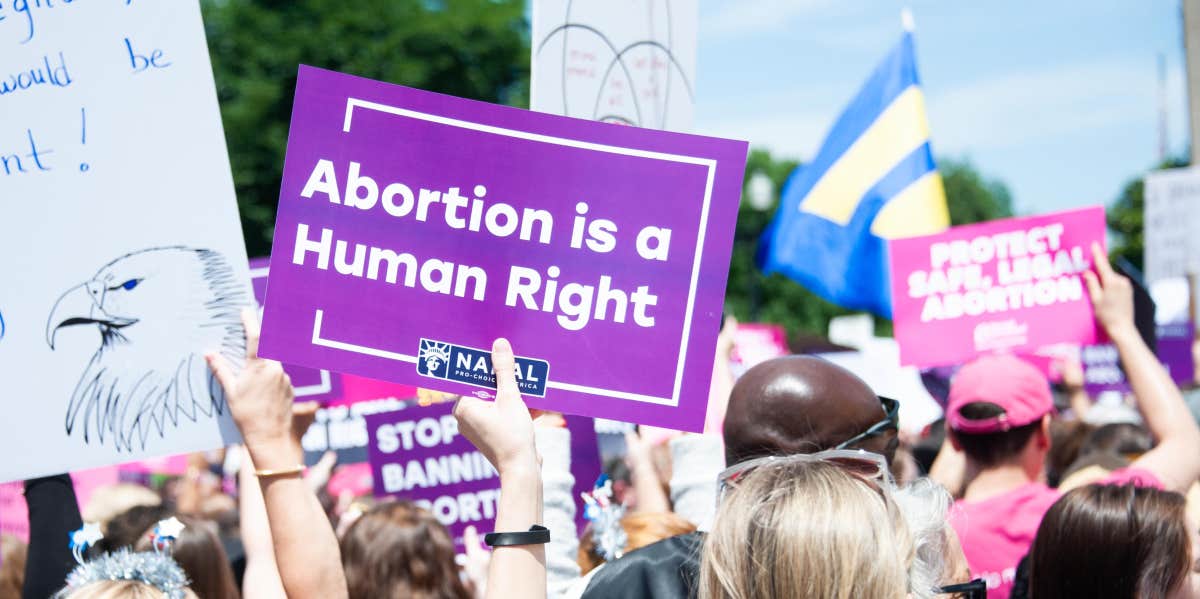What Actually Happens When Abortion Is Banned — And Why Being Pregnant Is Now More Dangerous Than Ever
A frightening day for America.
 Rena Schild | Shutterstock
Rena Schild | Shutterstock On a harrowing day for America, the Supreme Court ruled to overturn Roe v. Wade in a 6-3 decision, making it so there will no longer be a federal constitutional right to an abortion.
Now, abortion rights will be determined by individual states, unless Congress acts. As of right now, nearly half of the states have passed or will pass laws that ban abortions, while other states have already enacted strict regulations.
Not only is this an infringement on a woman's right to choose, but overturning Roe v. Wade simply gets rid of safe abortions, not abortions altogether.
The Supreme Court will not stop abortions, they have just made them dangerous.
Instead, the rate of illegal and unsafe abortions will drastically increase, or people will be forced to carry out unwanted pregnancies.
According to a study conducted by the University of Colorado-Boulder, it was found that pregnancy-related deaths would increase by 21%, or 140 additional deaths overall if all pregnancies that currently end in abortion were instead continued to miscarriage or term.
Those numbers are only for the second year after an abortion ban.
The numbers would drastically increase for non-Hispanic Black women in particular, by 33%, causing 78 additional deaths and worsening the ongoing U.S. Black maternal health crisis.
Much of those numbers can be higher, especially when people having abortions are on average less advantaged than people giving birth, and at a higher risk of suffering from pregnancy-related death.
When abortions are performed by a trained medical provider, they are an overwhelmingly safe procedure. But, when abortions take place in unsafe conditions, which are almost half, 35 million, an estimated 23,000 deaths occur each year.
If you look at other countries that have banned abortions altogether, like Romania, the results were catastrophic.
In 1966, Nicolae Ceausescu, the leader of Romania, outlawed safe access to abortions and contraception in an attempt to boost the country's population. While the idea worked for a short time, the long-term effects were devastating.
Birth rates fell drastically as women found ways around the ban. Wealthy, urban women were able to bribe doctors to perform abortions, or they had contraceptive IUDs smuggled in from Germany.
But for low-income women and disadvantaged groups, they turned to back-alleys for abortions, and by 1989 an estimated 10,000 women died as a result of unsafe procedures.
The number of children turned over to orphanages also increased, and when communism fell in Romania in 1989, an estimated 170,000 children were found in unkept orphanages.
Many countries in Latin America are also home to the most restrictive abortion laws in the world.
Margaret Wurth traveled to some of those countries and spoke to family members of women who had died due to lack of access to safe abortions, writing about the experience for Human Rights Watch.
"In the Dominican Republic, I spoke with Rosa Hernández, whose daughter Rosaura Almonte Hernández was diagnosed with leukemia," Wurth wrote.
"Doctors initially denied her chemotherapy because she was pregnant, and then refused to end the pregnancy because to do so would have been against the law. She died in 2012 at age 16. “They let my daughter die,” her mother told me."
Wurth wrote about a woman in Honduras who was jailed after having a miscarriage, unaware that she was even pregnant, and an 11-year-old girl who was raped by her stepfather and therefore unable to get an abortion.
Those are the horrors that women face without being able to choose whether they want to bring a child into this world or not.
There are so many more consequences that go into banning abortions than just the unsafe proponent.
A study in the American Journal of Public Health found that women denied an abortion experience an increase in household poverty lasting at least four years longer compared to women who received an abortion.
Women were found to not have any money to cover basic expenses like food, housing, and transportation, years after being denied an abortion.
Another study found that denying abortions kept women in contact with their violent partners, putting not only themselves but their children at risk for physical and emotional harm.
Many people in the pro-life movement assume pro-choice activists love abortions when in reality we don't. If people could avoid having abortions, they would. It's traumatizing, and a downright awful experience to have to go through.
But it's the choice that matters. No one loves abortions. No one loves having abortions. The thing that matters is that it's an option for people and what they choose to do with their bodies.
Banning abortions is not a solution to some outdated thought that women's bodies aren't their own.
Lawmakers and Supreme Court officials are simply making it known that women are secondary citizens in this country, but we won't stop advocating and fighting until abortion rights are restored.
RELATED: If Roe V. Wade Is Overturned, Abortion Access Will Not Be The Only Human Right At Risk
Nia Tipton is a writer living in Brooklyn. She covers pop culture, social justice issues, and trending topics. Keep up with her on Instagram and Twitter.

